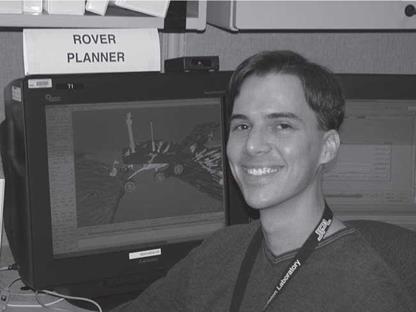Meet the Rover Drivers
Behind every successful robot rover there’s a driver. Actually, fourteen drivers in the case of Spirit and Opportunity. For those people used to the gray, male gristle of the typical scene at Mission Control in Houston, the rover drivers are surprisingly young, and many are women. Drivers don’t control the rovers in real time with a joystick; the reasons are that real-time control would be far too hazardous, and there’s no immediate feedback. Depending on where the Earth and Mars are in their orbits, the distance can vary from 35 to 200 million miles, and the time delay for a signal can be as high as twenty minutes.
The drivers are part of a much larger team of engineers and scientists, numbering over two hundred, who are all involved at some level in what the rovers do. On a typical day, the results of the previous day—which are part of a larger strategy involving weeks or months of roving—are evaluated as quickly as possible, usually within an hour. Then the drivers work with the science team to map out the day’s activities, which might involve measurements of an interesting rock or navigating around obstacles. This is turned into a set of commands that the rovers can execute. Commands are turned into a realistic animation and reviewed with the science team. Then they are picked apart for anything that could go wrong. All possible contingencies are considered. The final list of commands is reviewed twice and sent to the rovers to execute. Then the process starts again, as it has for over 2,500 days. The only break comes during each Martian winter when the rovers hibernate and conserve power.
|
Figure 3.4. Scott Maxwell works at NASA’s Jet Propulsion Laboratory and is a senior driver for the Mars Exploration Rovers. Maxwell has a background in computer science and was a software engineer before becoming one of the rover drivers. He recounts his experiences on a blog called “Mars and Me,” at http:// marsandme. blogspot. com (Courtesy Scott Maxwell and NASA). |
There’s a catch. A Martian day is 40 minutes longer than a Ter – ran day. So each day drivers begin their days 40 minutes later than the day before. As driver Scott Maxwell has said, “Pretty soon, you’re starting your day at midnight, at 2 a. m., at 4 a. m. (figure 3.4). It’s been called ‘Martian jet lag’—it’s tough on bodies, on brains, on relationships.”31 It leads to fatigue, which leads to mistakes. So many drivers watch their caffeine intake and keep to Mars time even on their days off, which puts further strain on relationships and adds to the “otherworldliness” of the job. As for what it feels like to control a robotic vehicle on another planet, listen to Ashley Stroupe, one of the most experienced drivers: “It’s really just awe inspiring. Probably the closest I’ll ever get to being an astronaut. Going to new places and being the first human eyes to see them is profound and hard to describe. It’s the best job I could imagine.”32
The different personalities of the rovers project into the driving experience, as Stroupe explains: “The rovers do behave differently!
Spirit and Opportunity are first in very different terrains, and so you have to drive them differently. Also, they have aged differently and have driven us to use very different strategies. We have to drive Spirit mostly backward to drag the broken right front wheel, and we have to drive Opportunity with the robotic arm out in front since one of the joints broke and we can’t stow it anymore.” There are also light moments, as Maxwell describes in his online blog: “Early in the mission, we nearly lost Spirit due to a problem with its flash file system. When we’d diagnosed and fixed the problem, cleaned up the flash drive, and knew that the danger was past, someone wrote this on one of our white boards: Spirit was willing, but the flash was weak.” His greatest driving challenge was trying to get Spirit to a safe haven for the winter by driving across a dune with a balky wheel. As he said, “Imagine trying to cross a desert pushing a shopping cart with one stuck wheel.”











